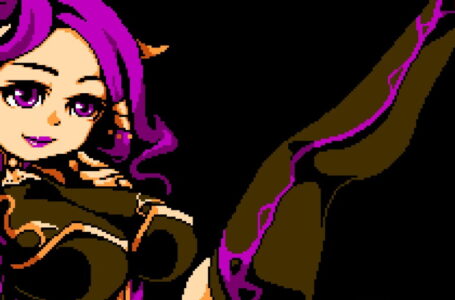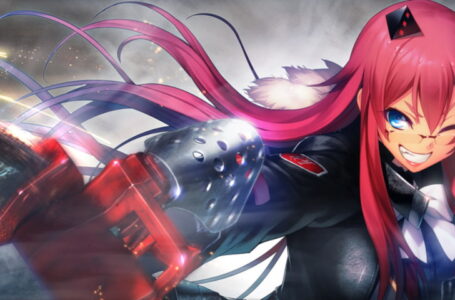Some first tentative steps into Full Metal Daemon Muramasa

A brief preamble before we get started today, if you’ll indulge me a moment. Just before the New Year, we had some excellent contributions to the Rice Digital Friday Letters Page, which included a request from one Alfred Scott for us to take a look at the newly fan-translated Nintendo DS RPG Luminous Arc 3, and the officially localised visual novel Full Metal Daemon Muramasa — assuming we were able to fit them in.
Our resident Luminous Arc fan Lilia was more than happy to take on the challenge of Luminous Arc 3, and so that left Full Metal Daemon Muramasa. This was a visual novel that I’d been following for a while, since it became clear that it was a monumentally challenging localisation project — indeed, one that many had seemingly assumed for quite some time would never happen under official circumstances. With that context, of course I wanted to cover it.
Only one trouble: to cover a visual novel properly, you really need to read all of it. And Full Metal Daemon Muramasa isn’t the sort of thing that you can quickly skim over while you’re on the toilet; the fan-voted average time estimate on VNDB places it in the “Very Long” category at somewhere around the 70-hour mark, which means a significant time commitment to get through it. Not only that, it’s quite a challenging read, too; like many of developer Nitroplus’ other titles, it’s a densely wordy affair, filled with evocative descriptions, changes of narrative perspective and fascinating, complicated characters. One that requires the reader’s full attention, then.
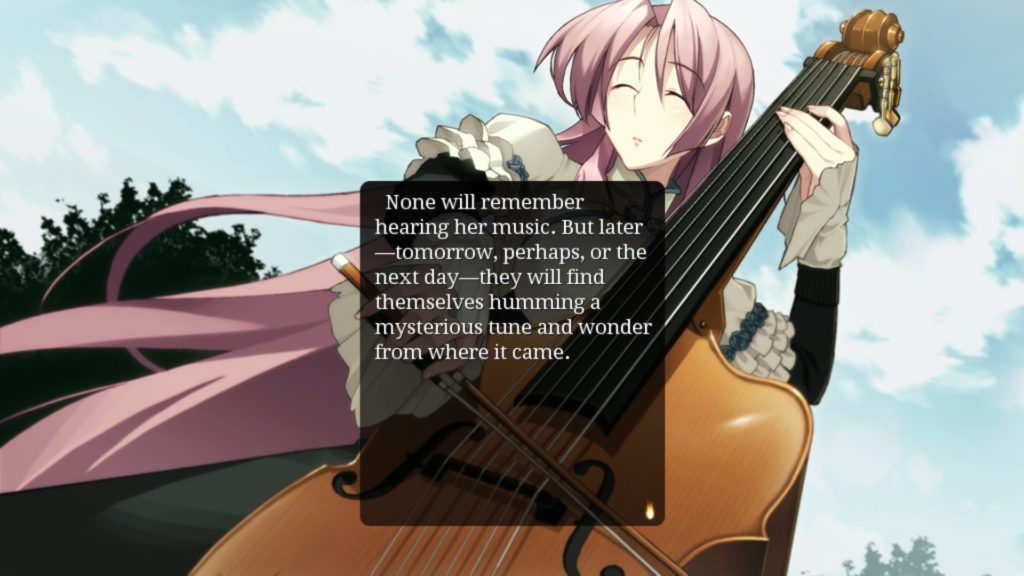
So, I pondered, how best to tackle this in a reasonably timely manner? This was not a game I could just bang out over a weekend and then throw up a couple of thousand words the following Monday. This was a game that demanded some proper analysis and a genuine deep reading — the sort of thing that you don’t normally get on gaming websites, in other words.
Then it occurred to me: when we’re looking at anime, manga, light novels and other long-form narrative media, we don’t necessarily cover the whole thing in one go. You might cover an anime an episode or season at a time depending on its complexity; a manga or light novel a volume or chapter at a time; you might even take a different approach and explore specific themes and characters in their own dedicated articles. So why shouldn’t it be the same for a work as complex and challenging and Full Metal Daemon Muramasa?
There is no reason. So that’s what we’re going to do. Over the next [presently indeterminate amount of time], I’ll be reading Full Metal Daemon Muramasa and providing semi-regular progress reports along the way. Sometimes we’ll be talking about the narrative, sometimes about the themes, sometimes about the characters and sometimes about the broader context of things. Sometimes there will be spoilers — they’re unavoidable when discussing a medium that is pretty much nothing but narrative, after all — and sometimes we might be able to get away with talking in more general terms. But hopefully it should be consistently interesting.
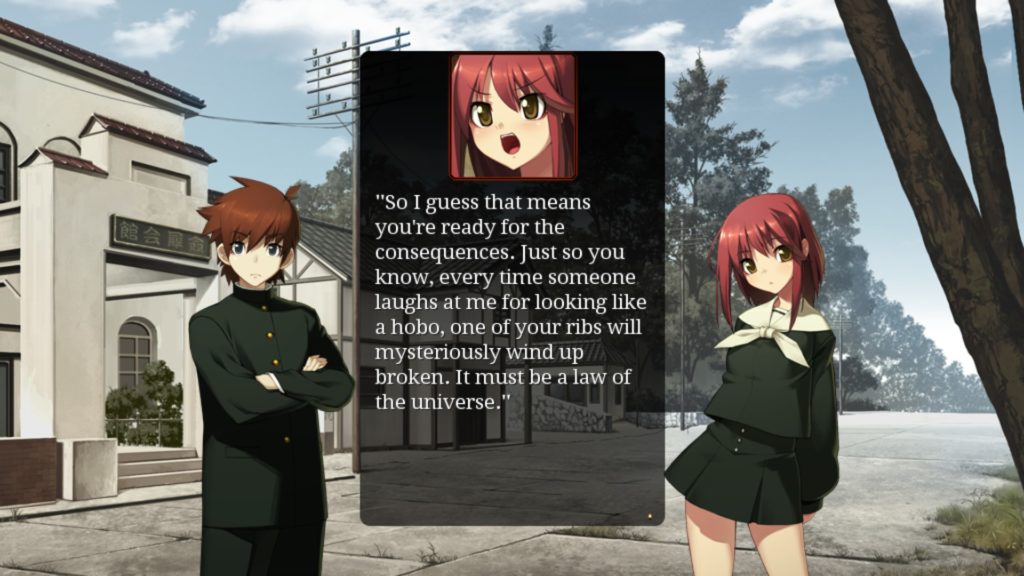
A bit about Full Metal Daemon Muramasa
So let’s begin with some overall context of what Full Metal Daemon Muramasa actually is, because some of you reading this might not be familiar with it at all, some of you might have drawn some conclusions based on hearsay, and some of you might even have misunderstood what it actually is based on what you’ve heard.
Full Metal Daemon Muramasa, also known as Soukou Akki Muramasa, is a visual novel that was first released in Japan in 2009 by Nitroplus, creators of popular classic visual novels including Deus Machina Demonbane, Saya no Uta and the Science Adventure series that includes Steins;Gate, Chaos;Head and more.
Muramasa’s art is by Namaniku ATK, whose other work includes art and character design for the anime and light novel series Hitsugi no Chaika, and its writer is Ittetsu Narahara, whose other work includes the visual novel Hanachirasu and its spinoff Kaigen Seito, the former of which is also available in English from localiser JAST USA.
Narahara is an expert in traditional Japanese swordplay — known as Ko-ryuu kenjutsu — and thus his work often incorporates elements drawn from samurai culture as well as highly detailed descriptions of both single combat and larger-scale battles. Full Metal Daemon Muramasa was the last project Narahara worked on with Nitroplus, but it has endured this long not just because it’s one of the best visual novels by the company, but because it’s commonly regarded to be one of the best visual novels of all time.
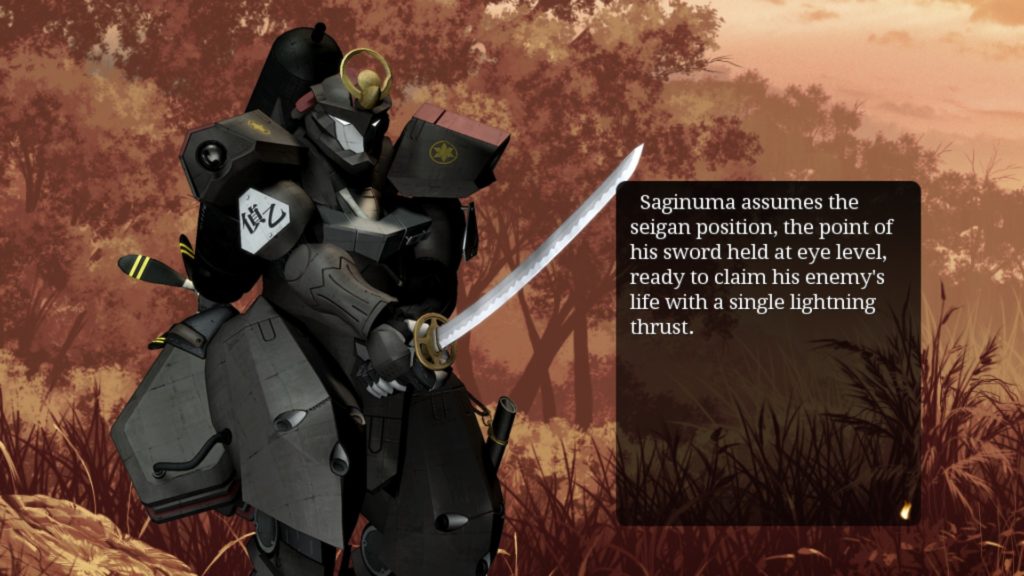
Muramasa’s localisation was regarded as a significant challenge for a number of reasons — not least of which was the fact that Nitroplus made the stylistic decision to present the original Japanese version using vertical writing rather than the more traditional “ADV” or “NVL” styles, which feature text boxes at the bottom of the screen or covering the whole screen respectively.
Since there’s not really a good equivalent for vertical writing in Roman script, the team behind Muramasa’s localisation had to make some tricky choices: completely revamp the game’s interface, knowing that the whole visual design of Muramasa was based around this “vertical” presentation, or do something a bit different from the norm?
They opted for the latter option, preserving the feel of the original vertical text by featuring a tall, narrow text box that, for the most part, appears in the middle of the screen with characters in the scene standing either side of it. These full-body characters tend to remain relatively static for the most part; emoting is instead handled through a combination of the writing, voice acting and close-up facial portraits of the characters who are speaking at the top of the text window.
You’d be forgiven for assuming this might be a jarring way to present things if you’re accustomed to the aforementioned ADV or NVL-style visual novels we more commonly see localised outside of Japan. But, surprisingly, it feels natural very quickly; as we’ve said, Muramasa as a whole was designed entirely around this “vertical” presentation of its text, and this still comes across with the tweaks that have been made to ensure it works in English. You’ll be immersed before you know it.
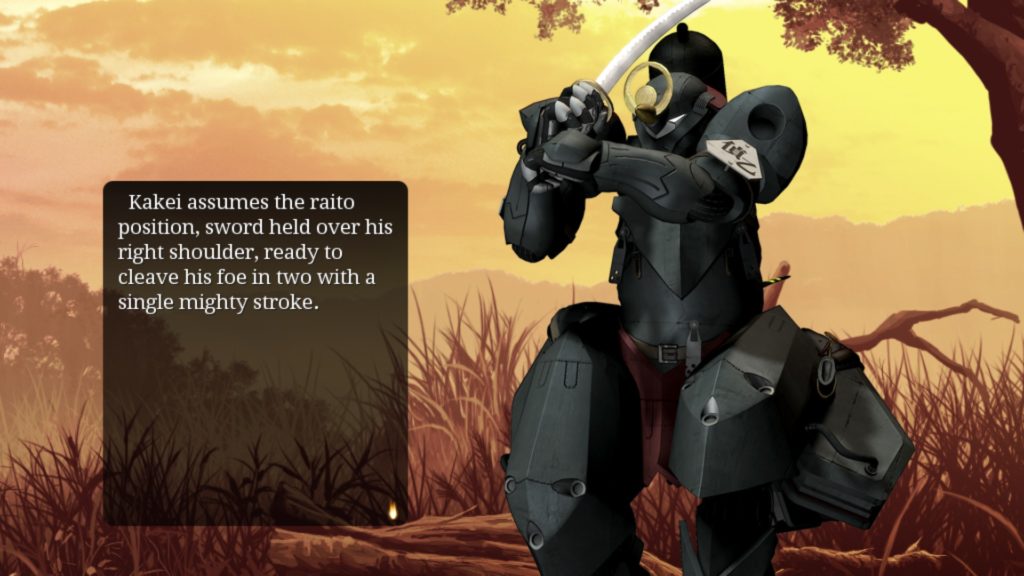
An introduction in four acts
Full Metal Daemon Muramasa opens with a rather dramatic sequence that is fairly typical of Nitroplus: it’s dark, it’s violent and it most certainly does not shy away from vivid descriptions of absolute atrocities unfolding before you.
Beginning with a spectacularly tense clash between two rival pilots of the supernaturally powered “tsurugi” suits of armour that form the backbone of Muramasa’s narrative and proceeding onwards to an uncompromising description of a violent massacre, it’s hard to look away, however much you might want to.
But the masterful thing about this introduction is that very little is made truly explicit through anything other than the text itself. There are occasional blood splatters that splash across the screen and some truly haunting screams from the voice actors involved, but for the most part all the heavy lifting in this scene is being done in your own mind as a result of the words that you’re reading on the screen. It’s absolutely horrifying and strangely compelling — and it sets up a thoroughly intriguing narrative context for what is to follow.
Let’s back up a moment and talk about what actually occurs here, though. Full Metal Daemon Muramasa unfolds in an alternate history Japan — here known as Yamato — around what would be the year 1940 in our calendar. Yamato is ruled by the Rokuhara Shogunate who are, to say the least, not very nice. Resistance to their rule is quickly wiped out decisively and dramatically as an example to others who would consider standing up against them — and it’s this we witness in this opening scene.
Except the village that the Rokuhara forces destroy is not really openly rebelling against the shogunate; rather, they simply gave shelter to an ageing warrior who had once betrayed the Rokuhara. This, however, is enough for the Rokuhara commander — an old rival of the warrior in question, and someone who felt personally affronted by his betrayal — to denounce the village as worthy of complete and utter destruction, leaving only the women and children as survivors to take as slaves.
All is proceeding in suitably bloody fashion when a mysterious silver tsurugi known as Ginseigo appears, absolutely obliterates everything nearby — Rokuhara and villager alike — before buggering off into the sky, pursued by a crimson rival. The whole situation leaves us firmly convinced of Rokuhara being thoroughly nasty pieces of work — but what are the true intentions of this silver figure, and the crimson warrior that pursues it? We’re left with plenty of questions — very few of which we get immediate answers for.
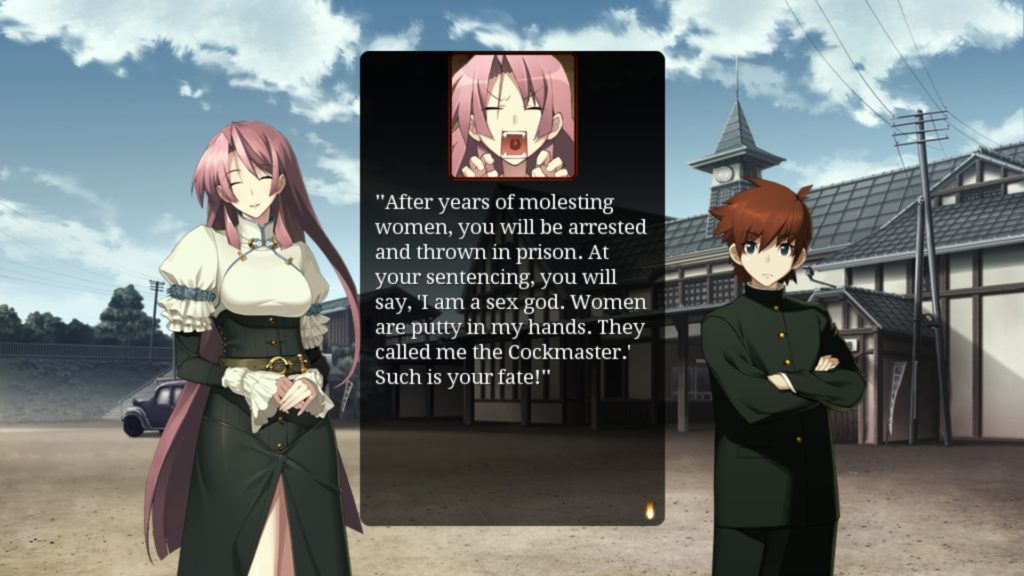
High school heroes
After that chaotic, violent opening, you’d be forgiven for assuming that the rest of Full Metal Daemon Muramasa would unfold in some sort of ruined, burning post-apocalyptic landscape, but that’s not the case at all; instead, we switch perspectives to an initially unknown protagonist who spends several pages of text atop a black screen informing us of how waking up with leg cramp is the absolute worst thing imaginable, followed by his realisation that being woken up by his overly violent childhood friend putting him in a leglock is, in fact, a much worse way to start the day.
From hereon, we’re into a much more “slice of life” sort of story that follows three high school kids: our first-person perspective apparent protagonist Yuhi, the aforementioned childhood friend Konatsu, and their mutual friend Tadayasu. The three are concerned when their ohohoho-ing delinquent ojou-sama friend Ritsu doesn’t show up to school, and when she continues to be missing for several subsequent days, they start worrying that something more significant has happened to her.
What then follows are the group’s attempts to track down exactly what might have occurred — with their fears growing by the moment that she might have been taken by Rokuhara slavers. The general population doesn’t know for sure that Rokuhara takes and sells slaves, but rumours abound. And to make matters worse, we as the audience have already seen first-hand that they most certainly do take slaves — and it’s not difficult to assume what probably happens to young female ones.
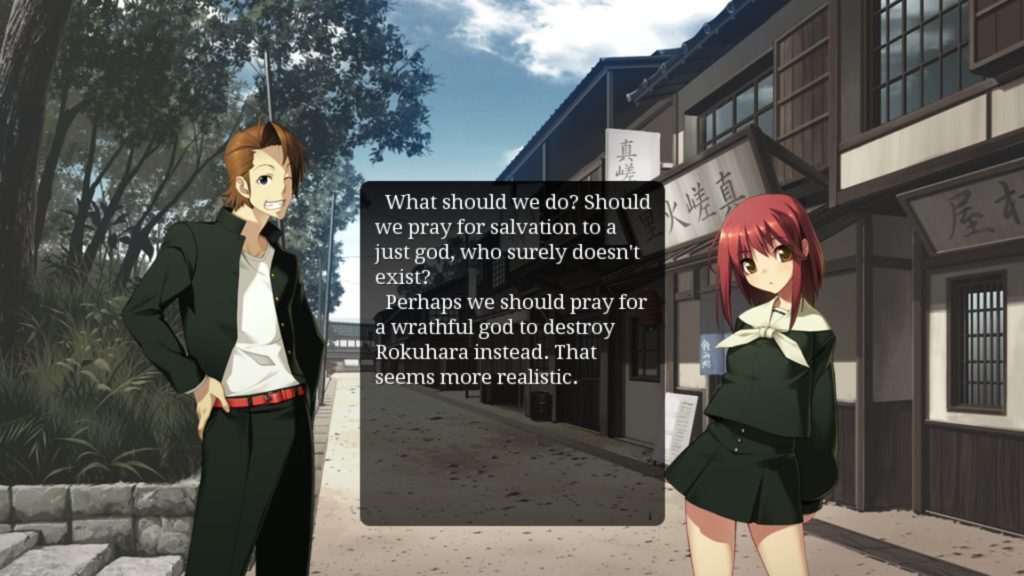
This whole sequence is rather interesting, because it carries with it the somewhat light-hearted levity of a typical slice-of-life tale — indeed, many of the interactions between Yuhi, Konatsu and Tadayasu are genuinely amusing — but with the colour of the scene somewhat sullied by several pieces of knowledge we gradually establish firmly in our mind.
Firstly, the memories of that initial massacre will likely be fresh in most readers’ minds, meaning we know what Rokuhara is truly capable of; secondly, Yuhi and company are well aware of how Rokuhara is oppressing Yamatoan society, since the general public been having to deal with rationing for years despite any “war” being long over; and thirdly, of course, we know that something unknown and likely very unpleasant has happened to Ritsu.
In this way, there’s sometimes a touch of “gallows humour” about this sequence; you get the impression that Yuhi, Konatsu and Tadayasu really are struggling to come to terms with what is going on, but as kids who aren’t quite ready to truly process some of the emotions they’re doubtless feeling, they don’t quite know what the best way to deal with the situation is. And so, as many people do during times of discomfort, they turn to humour; it’s better to laugh than to cry, after all.
Their investigation initially appears somewhat fruitless, though they do manage to uncover a few possible leads. They reach a turning point when they encounter a mysterious shadowy figure, though — one Yuhi describes as “handsome, objectively, but whose positive qualities are utterly eclipsed by the aura of darkness that surrounds him”.
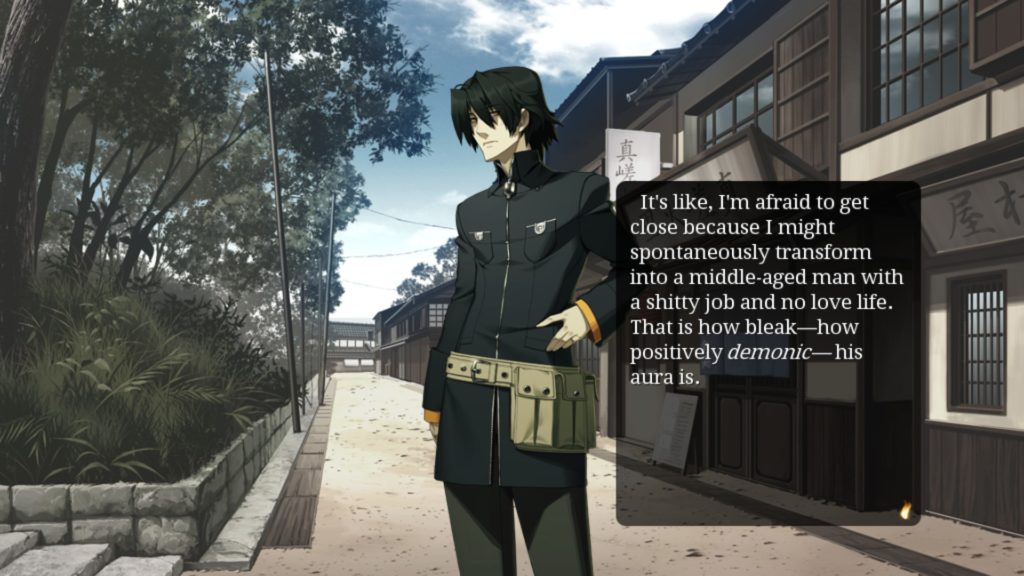
Naturally, being dumbass kids, they immediately assume that the figure in question is evil and thus likely to be behind their friend’s disappearance — with that in mind, they violently assault him in an attempt to get some answers out of him. Oddly unperturbed by this — even once the group discover, after knocking him out, that he is actually a member of the local police force — he reveals that he is actually also pursuing the truth behind Ritsu’s disappearance, but that his interest in the case supposedly ties in with the matter of the silver tsurugi Ginseigo.
If you’ve read the manual or the promotional material for Full Metal Daemon Muramasa, you’ll quickly notice that the shadowy figure with the demonic aura is Kageaki Minato, the real protagonist of this tale — though at this point it remains to be seen exactly how (and, indeed, if) the perspective switches to his viewpoint as the story progresses.
But that’s something to explore another day. Suffice it to say for now that the opening to Full Metal Daemon Muramasa does a great job of setting things up, establishing the narrative context and overall setting in several distinctly different ways, and raising plenty of questions that will hopefully be answered as this lengthy story proceeds down one of its several possible paths.
For now, then, that’s where we’re leaving things — so let’s pick things back up again very soon!
Full Metal Daemon Muramasa is available now from JAST USA.
Join The Discussion
Rice Digital Discord
Rice Digital Twitter
Rice Digital Facebook
Or write us a letter for the Rice Digital Friday Letters Page by clicking here!
Disclosure: Some links in this article may be affiliate links, which means we may earn a small commission if you make a purchase after clicking on them. This is at no additional cost to you and helps support Rice Digital!
- Letter from the Editor: passing the torch - June 30, 2023
- Super Woden GP 2 is looking promising - June 30, 2023
- Inti Creates is making a 32 bit-style Love Live action platformer - June 26, 2023




